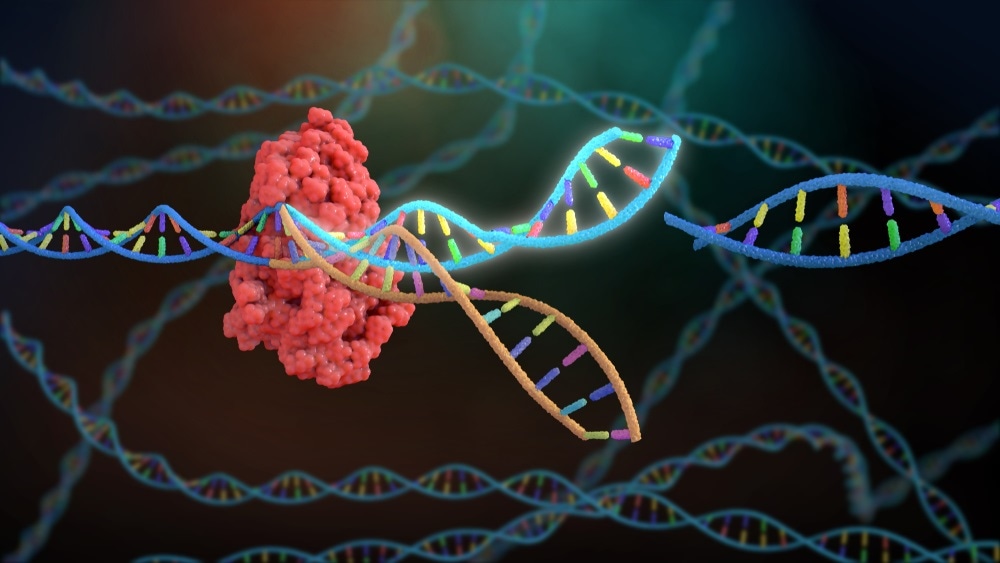Researchers at Columbia University, New York, have used a Nobel Prize-winning technique to capture images of a new gene-editing tool that could help scientists improve upon current CRISPR-based tools.
 Image Credit: Nathan Devery / Shutterstock.com
Image Credit: Nathan Devery / Shutterstock.com
The new gene-editing tool, called INTEGRATE, was developed by Sam Sternberg, Israel Fernandez, and colleagues after they discovered a "jumping gene" in the bacteria Vibrio cholerae that could precisely introduce large gene sequences to the genome, without causing DNA breaks.
Currently, the CRISPR-Cas9 tools researchers use to modify the genome involve cutting both strands of target DNA, creating a DNA break that the cell then needs to fix. Researchers are still finding this repair process difficult to control, and undesired or "off target" gene edits are often introduced into the genome.
Capturing high-resolution images of the new gene-editing tool
As reported in the journal Nature, Samberg and team used the Nobel Prize-winning technique cryo-electron microscopy to capture high-resolution images of the new gene-editing tool in action to understand exactly how it works.
"We showed in our first study how to leverage INTEGRATE for targeted DNA insertions in bacterial cells," says Sternberg. "These new images, a wonderful collaboration with Israel Fernández's lab, explain the biology with incredible molecular detail and will help us improve the system by guiding protein engineering efforts."
Using the cryo-electron microscopy technique, the researchers froze a sample of the gene-editing complex in liquid nitrogen and bombarded it with electrons. They then used electron microscopy to capture images of the complex and produce atomic-resolution structural models of the INTEGRATE system.
The team discovered that the complex is made up of two main parts arranged in a helical filament. One section – Cascade - wraps around and carries a guide RNA that searches the cell for a matching DNA sequence. Once it binds to the target DNA, it threads the sequence through "transposition" proteins located at the end of the complex that recruit enzymes to help modify it.
The difference between INTEGRATE and current CRISPR tools
This scanning mechanism seems to work similarly to other CRISPR systems, some of which also involve a Cascade and guide RNA complex. However, with these other systems, Cascade is used to target DNA for cutting, whereas the Cascade used in INTEGRATE targets it for accurate insertion of genetic sequences.
First author Tyler Halpin-Healy says that visualizing biology on this scale is truly amazing and can easily excite even those unfamiliar with the topic.
The quality of this work, and the speed at which it was accomplished, is emblematic of the collaborative environment afforded by great mentors like Sam and Israel."
First author Tyler Halpin-Healy
Since existing CRISPR tools often fail to precisely insert large genetic payloads, researchers are keen to improve the accuracy of gene editing to ensure the safety of any therapies developed using the technique.
Sternberg and team's new INTEGRATE tool accurately inserts large DNA sequences without resulting in DNA breaks that the cell then needs to repair. This could provide a more reliable gene-editing system than the current CRISPR tools. INTEGRATE could also prove useful for editing cells that have limited DNA repair, such as neurons, where the use of CRISPR has been relatively unsuccessful.
This work "will guide protein engineering efforts to leverage this system for programmable DNA insertions in genome-engineering applications," concludes the team.
Source:
Journal reference:
Halpin-Healy, T.S. et al. (2019). Structural basis of DNA targeting by a transposon-encoded CRISPR–Cas system. Nature. DOI: https://doi.org/10.1038/s41586-019-1849-0